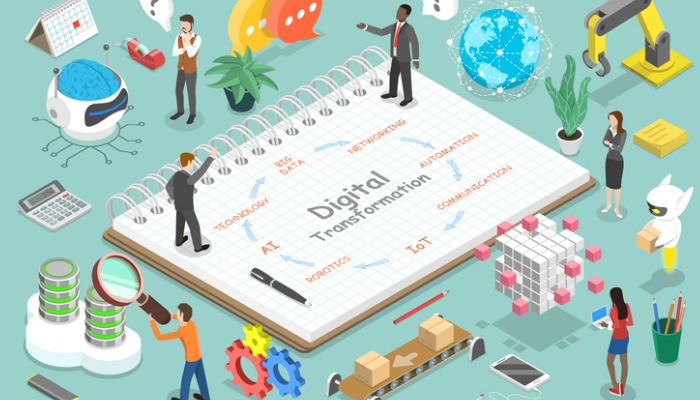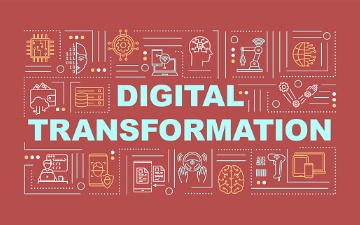Business IntelligenceCloud ServicesIT Consulting & StrategySecuritySoftware DevelopmentTech Support & Managed IT ServicesTelecommunicationsConstructionEducationFinanceHealthcareLegalNon-ProfitsReal EstateStartups
It’s hard to do anything in business these days without hearing about digital transformation. It’s often touted as the thing that’s going to help businesses stay competitive in the modern world, but there are a lot of questions around digital transformation. How will it help your business, and why is it something you would want to embrace?
Digital transformation is the act of working technology into your business in a way that helps you become more competitive, makes it possible to better serve your customers, and that boosts employee productivity. The ultimate goal in digital transformation is creating a business that implements technology that lets you run your company like a modern company should be run.
But, the question that often comes is, “Why would I change anything? Everything is going well the way it is now.” It’s a fair question, but as 2020 has shown us if you’re not ready to adapt to the challenges that the world throws at you, you’re going to struggle when something major (like a global pandemic) requires you to shift the way you operate.

What’s so important about digital transformation?
At its core, digital transformation helps you with three specific areas of your business. It brings in tools and processes that help you boost productivity, it makes it possible to offer products and services that your competition doesn’t, and it helps you be flexible enough to adapt to whatever happens in the world.
Companies who embrace digital transformation often find that not only does it have a positive effect on their business, but according to Deloitte, 45% of them reported higher net revenue growth as well. This tends to happen because they’ve focused on creating a stronger path for growth that also lets them react to the world almost in real-time, instead of always playing catch up with the competition.
How does digital transformation help businesses?
What digital transformation can help your business depends on what you’re hoping to achieve. Everyone’s journey through the process is going to be different. The first thing that you’ll need to do is figure out exactly what it is that you’re looking to do within your company. Your goals will determine what your digital transformation journey looks like, as well as the kinds of changes that you make.
Here are some ideas that give you a sense of why you’d want to implement various digital transformation initiatives and how they’re going to help your business.
Greater flexibility
We saw this one play out in real-time in 2020 as the world shifted the way it worked thanks to the COVID-19 pandemic. When businesses don’t have systems in place that allow them to adapt, they flounder. Those that are ready will go with the flow.
Digital transformation efforts can help your business be ready for things like suddenly having your entire company working remotely. You achieve this with tools that let you hold meetings remotely (Zoom), inter-company messaging (Slack), or that make it possible to collaborate remotely (Microsoft Teams), among other things. This flexibility doesn’t have to be limited to helping your employees work remotely, either. Your customers can benefit from it as well.
For example, helping your customers solve their problems remotely (through either video conferencing software or a custom-built platform) could allow you to troubleshoot problems and solve them. Anything that you can offer your customers that makes it easier for you to help them goes a long way, even something as simple as offering multiple payment options for your product or service. Increased productivity
Digital transformation helps pave the way for increased productivity from your team by introducing automation to your workflow. These automations are designed to take repetitive, low-value tasks away from employees. In doing so, you free them up to focus on tasks that fall within their zone of genius.
As an example, if you have a process where a customer fills out a form, then an employee needs to manually cut and paste the data from the form into your CRM (or your ordering system), which could be automated away. The task still gets taken care of, but your staff no longer have to stop what they’re doing to cut and paste something.
Boost efficiency
Custom-built software can also help unlock efficiency gains within your company. Rather than forcing third-party software to kind of handle the tasks you need it for or using software that delivers a sub-par experience that requires a lot of manual intervention, you can get bespoke software that was made for the job. Software experts (like ours) work closely with you to learn exactly what you need from a piece of software to improve your workflow. Then, they create software that does just that. It works for your business because it was designed for you and the way you work.
For example, say you’re using a video conferencing platform to capture your sales calls and you want to have them transcribed so you can easily monitor how your team is doing. If that platform doesn’t have an integration with your transcription provider, then you’d have to record the call, manually upload the recording to get transcribed, and then download the transcription afterwards. Rather than doing all the extra work that takes your team away from sales, you could build your own video conferencing platform that has a built-in integration to your transcription service. Or, you could take it one step further, and build out a system that is capable of transcribing, so all you have to do is save the transcription file at the end of the call.
Better response times
With the right tools, you never have to keep your customers waiting long for answers. Adding chat software to your website lets you respond to questions that your customers have almost immediately. The best part about something like this is that you have more than one option available to you when it comes to providing these answers.
With live chat, for example, customers can connect with humans at your company to get answers to their questions or even get the support they need to solve their problems. Rather than making people find your phone number, then leave your website to call (only to have them end up on hold) adds an unnecessary level of complexity to answering even the simplest questions (like “Do you have this in blue?”). What businesses are noticing is that not only are people more likely to purchase from a website that offers live chat, they’re more likely to return to sites with live chat, as well.
Along with being able to provide faster answers, your employees can help more than one customer at a time. Unlike phone calls where you can only have one conversation at a time without putting people on hold, live chat lets you engage with as many customers as you can handle at once.
Chatbots let you take the response time one step further by making it possible for you to provide support 24/7. Customers may not get all the answers they’re looking for with a chatbot, but they can provide answers to simple requests around things like inventory, hours of operation, and payment methods. Rather than making people wait until you’re open, they can get their answers right away.
Data-backed decision making
One of the ways that digital transformation really helps guide businesses is by allowing you to make highly informed decisions that are backed up by the data that you have within your company.
Regardless of what you do, your business generates a ton of data on a regular basis. The worst thing you can do for your business is just let that data sit there without being used. Digital transformation, through the introduction of business intelligence (BI) solutions, brings the data out into the open and lets you follow the trends in real-time.
Along with making it more visible, it helps you break down the traditional silos that tend to exist where marketing holds on to their data without sharing while sales also hold on to theirs. You get all your data in one place.
This means you can make data-driven decisions around marketing, the customer journey, your sales cycle, and more. When you integrate all your data properly, you can understand everything from who your best salesperson is, as well as what tactics they use that help them be the best. Then you can take that information and use it to create training programs for your other sales staff to help them close more deals.
You can also use the data gathered from the various touchpoints with customers to create incredibly specific advertising campaigns based on their preferences.
Finally, you can start to see where there are areas you might be underserving your customers. If you’re getting a lot of questions around a specific functionality that you don’t offer or people are asking why they can’t do something that your competition can do, a BI solution will make it easier for you to identify these new avenues. It could be a new product, a new module, or an existing one.

Need help with your digital transformation efforts?
Digital transformation can seem like a daunting task, but it doesn’t have to be. With the right partnership, you can get started quickly.
That’s where we come in. Through our digital transformation division, Exceed Digital, we can take the helm and guide you through the digital transformation process. From identifying the low-hanging fruit (the easy wins) to tackling major products like custom software that helps you be more productive, we can help.
If you’d like to find out more, contact us today.
[sales-phone] | [email-address]



 May 27, 2021
May 27, 2021 Homefield IT
Homefield IT

